
I love a good Top 10 list, don’t you?
Well, here’s one from me – my favorite Top 10 deer-resistant, spring-blooming plants for your garden!
Limiting this post to only 10 of my favorite spring-blooming plants was certainly a challenge, especially considering they also needed to be deer resistant to survive the hungry hordes that visit my garden.
But after three years of experimenting in my new garden, I’m pleased to share with you some of my favorites that do really, really well in my zone 9b garden:
1. Centradenia floribunda “Spanish Shawl”
Heavens, this is SUCH a performer in the garden!
When I moved from Los Altos three years ago, I took a little cutting of this from my garden, not knowing if it would survive in the intense heat that we get. Well, fast-forward three years, and I’d say it does just fine in the heat!
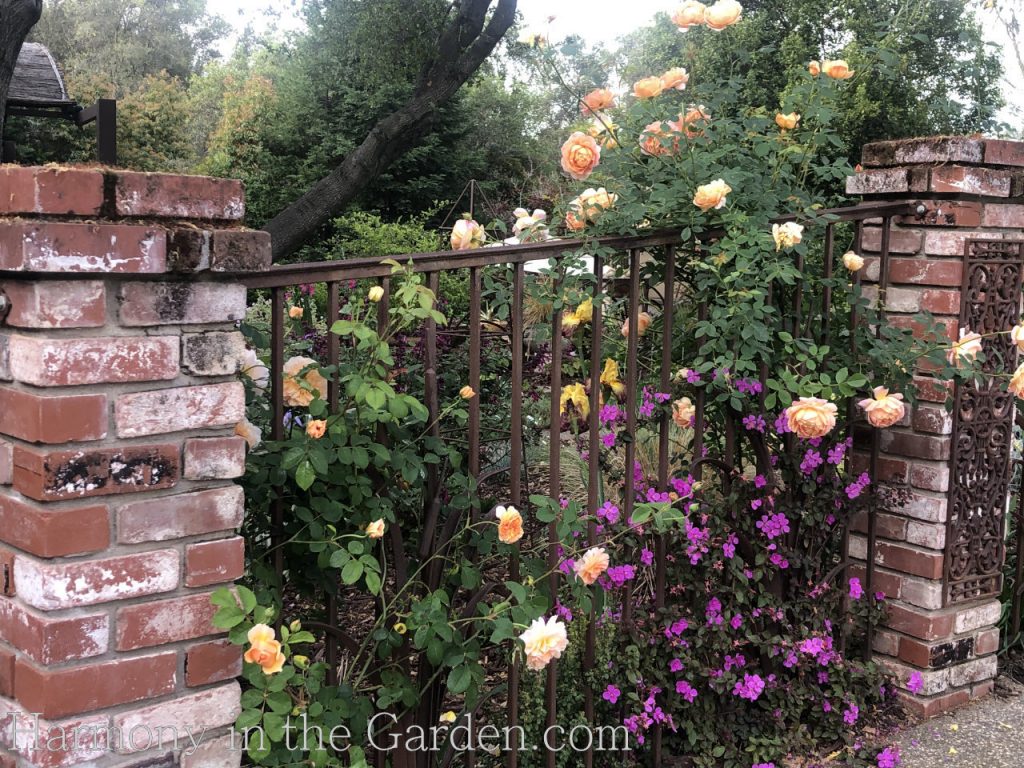
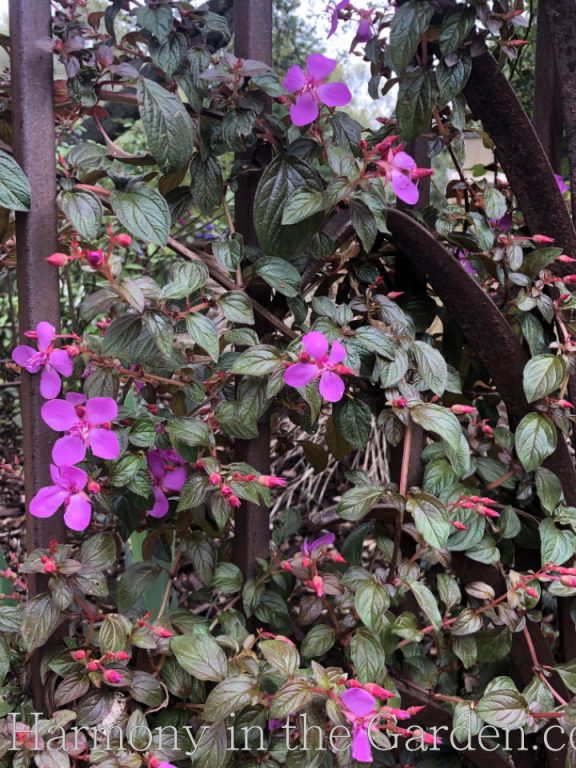
Here it is, scrambling through my wrought-iron fence, covering the bare canes of my ‘Lady of Shalott’ rose (in case you missed it, I wrote more about this rose in this recent post.)
Various websites say the Spanish Shawl needs a fair amount of moisture, but let me tell you that it gets very little in my garden and never wilts or shows signs of distress.
It’s semi-evergreen in the winter, only requiring a little pruning to keep it tidy. Then, once spring arrives, it puts on a show that lasts for a few months. MONTHS! And those burgundy tones in the foliage? What more could you want!?
2. Glaucium flavum aurantiacum “Horned Poppy”
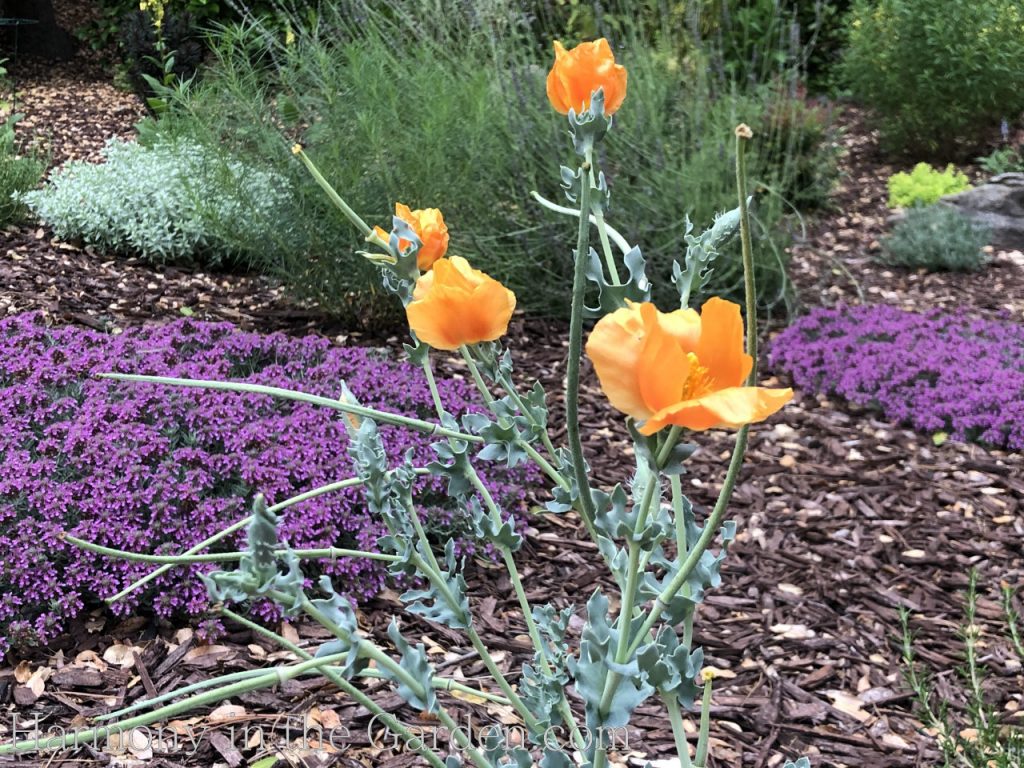
I found this little beauty at Annie’s Annuals and immediately fell in love with its crinkly and highly textured gray foliage. After learning that it isn’t fussy about soil, I thought it would be perfect in the baking-hot area that borders my driveway.
It requires fast drainage, though, which luckily isn’t a problem since this area is at the top of a gentle sloping berm.
After seeing how great it looks every single day of the year, I definitely plan on putting a few more in this spot.
3. Various Iris
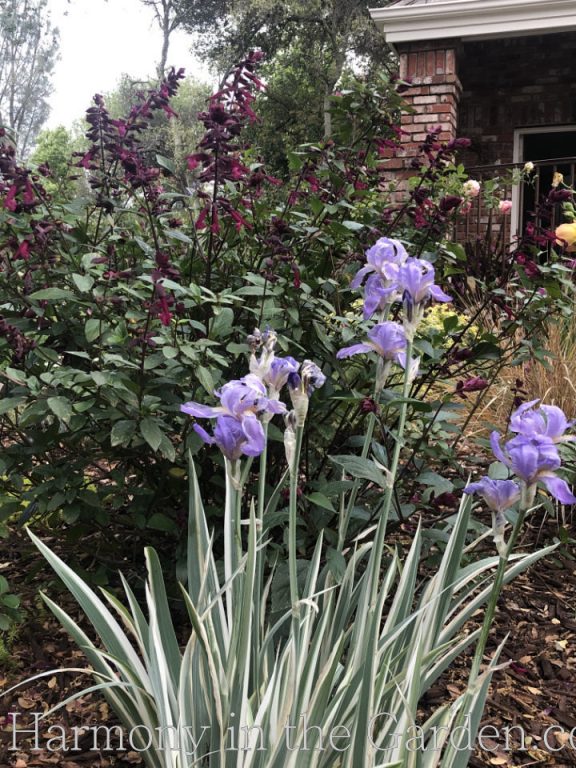
I’m a little late to the Iris Party, never really having much luck with them in my last garden.
I think it’s because my last garden was much smaller (1/4 acre vs. the 1-acre that I now have) and I couldn’t stand seeing the unsightly late-summer foliage for months at a time.
But now that I have a larger garden, I can strategically plant them so they’re a bit farther back in the garden beds, allowing attention to be focused on other plants during their downtime.
One of my favorites is the variegated foliage of Iris pallida ‘Albo Variegata’. Even if it never bloomed, I’d adore its crisp, variegated foliage.
But the scent of the light blue flowers has stolen my heart – they smell like grape soda!
In the late afternoon, when the weather is warm, the delicious grape scent perfumes my garden.
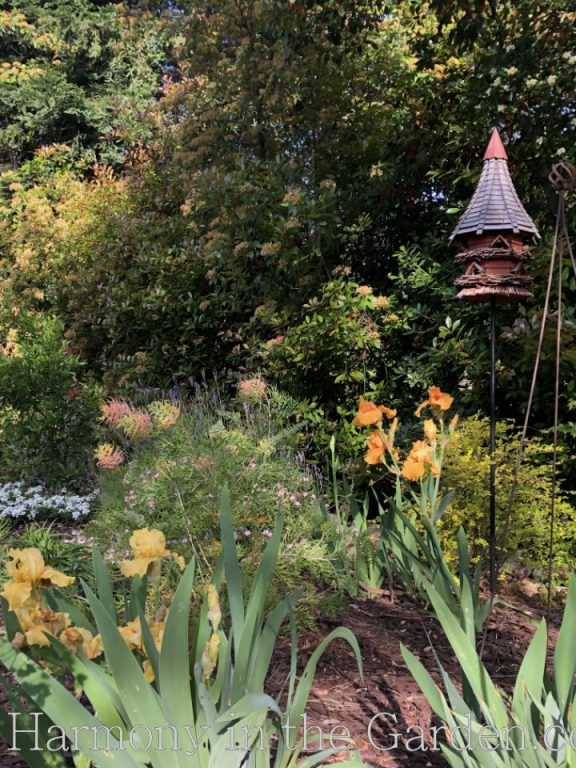
Another favorite iris is the tall orange flowers of ‘Voltage’ combined with the soft burnt-yellow of an unknown variety.
I just love how they harmonize with the neighboring flowers of the grevillea ‘Peaches & Cream’ (more about this plant, below!)
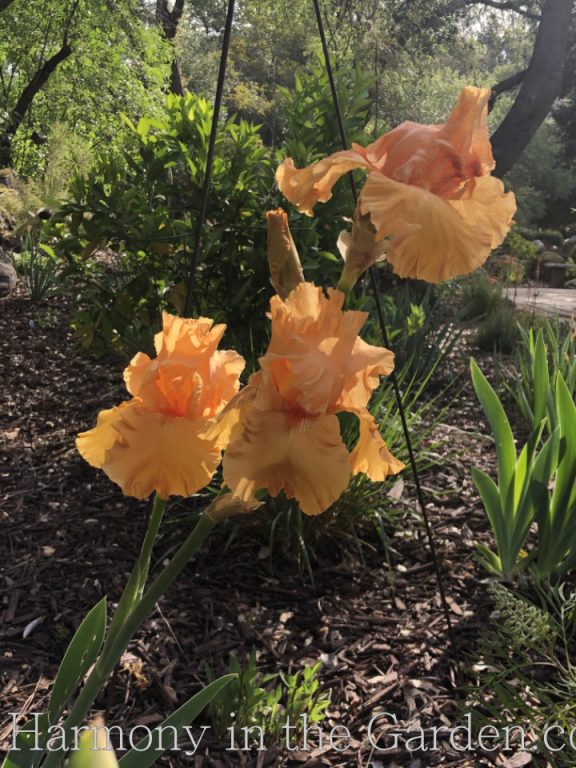
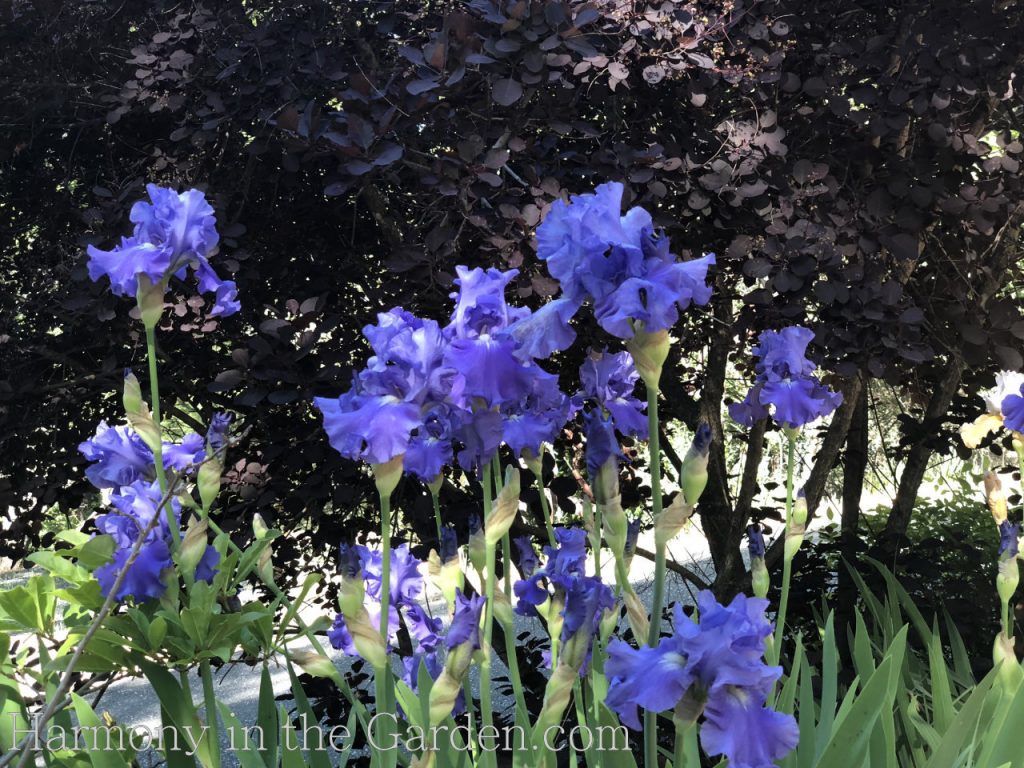
As you might remember, I’m a sucker for glaucous foliage, especially when its combined with dark maroon.
So, after seeing this knockout blue-green-burgundy combination in a nearby garden, I realized I needed to add some of these iris near my euphorbia ‘Blackbird’!
4. Grevillea ‘Peaches & Cream’
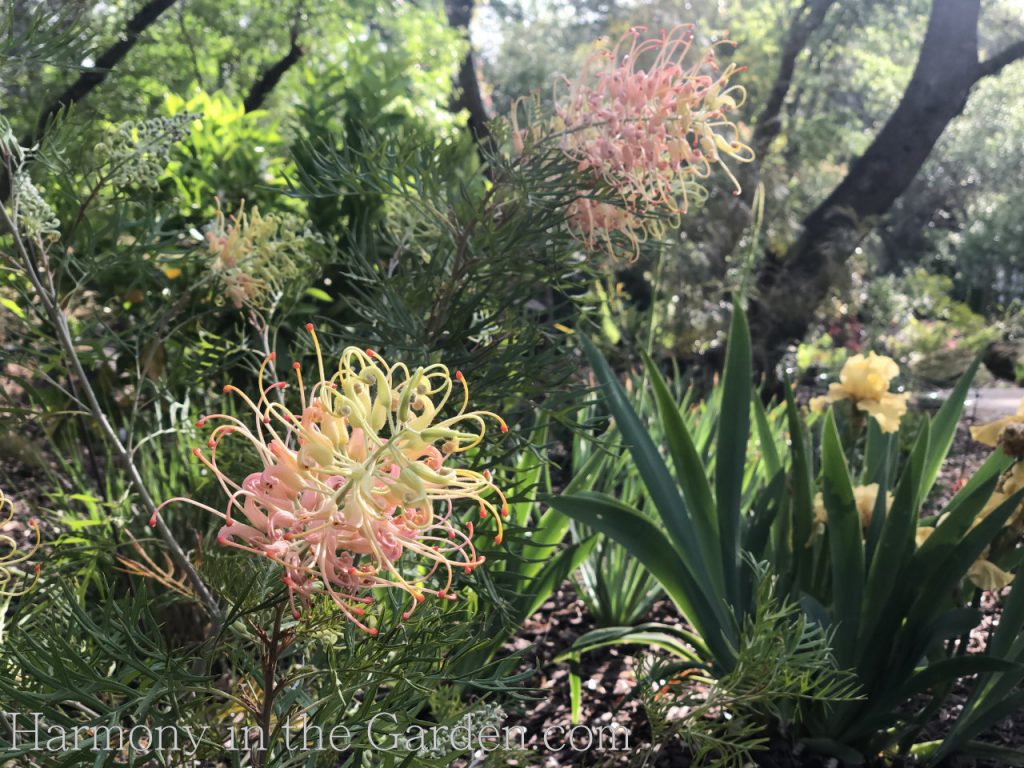
I have LOTS of grevilleas in my garden (which I’ll write more about soon,) but my ‘Peaches & Cream’ steals the show in the spring and summer with its unusual apricot and yellow flowers.
The flowers are HUGE, too, some topping out at 6-inches!
I have five of these in my garden, and they’re all incredible in either full-sun to part-shade. An added bonus is this variety is super fast growing, quickly reaching its ultimate size of 6′ x 8′ wide.
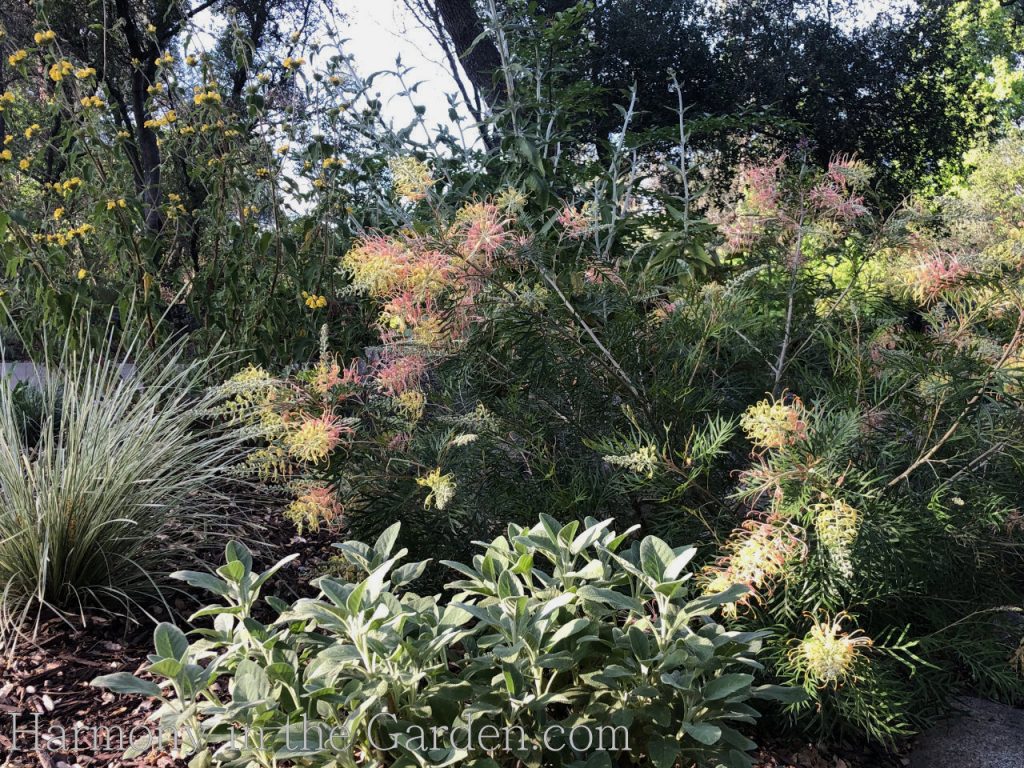
Even though our winter temperatures can occasionally dip into the high 20’s, my grevilleas haven’t been damaged one bit.
And since they originate from Australia, you know they’ll thrive with very little water in our blistering summer days.
5. Aloe ‘Fire Ranch’
I’ve gardened with lots of aloes over the years, but after receiving this small cutting several years ago I have to say this is one of my favorites of all-time.
It looks fantastic every day of the year, taking on various purple, blue, and green tones depending on the weather. It’s long leaves gently twist this way and that, creating an intriguing and unusual form.
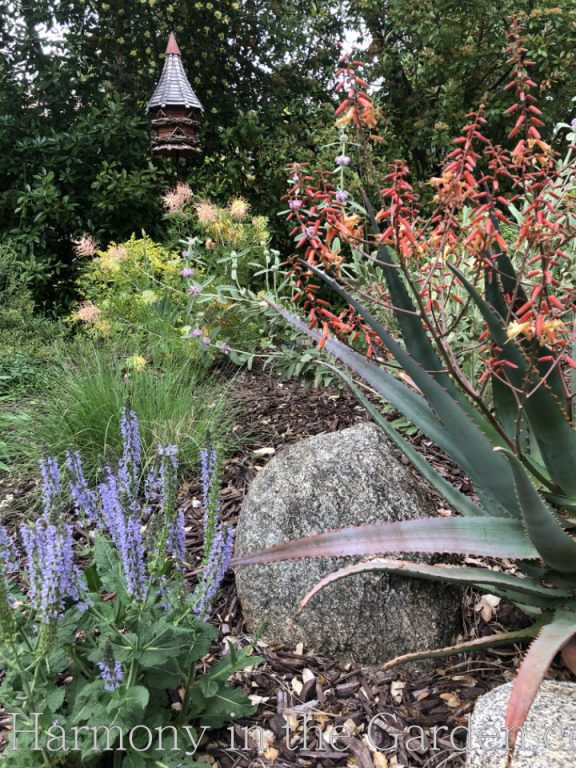
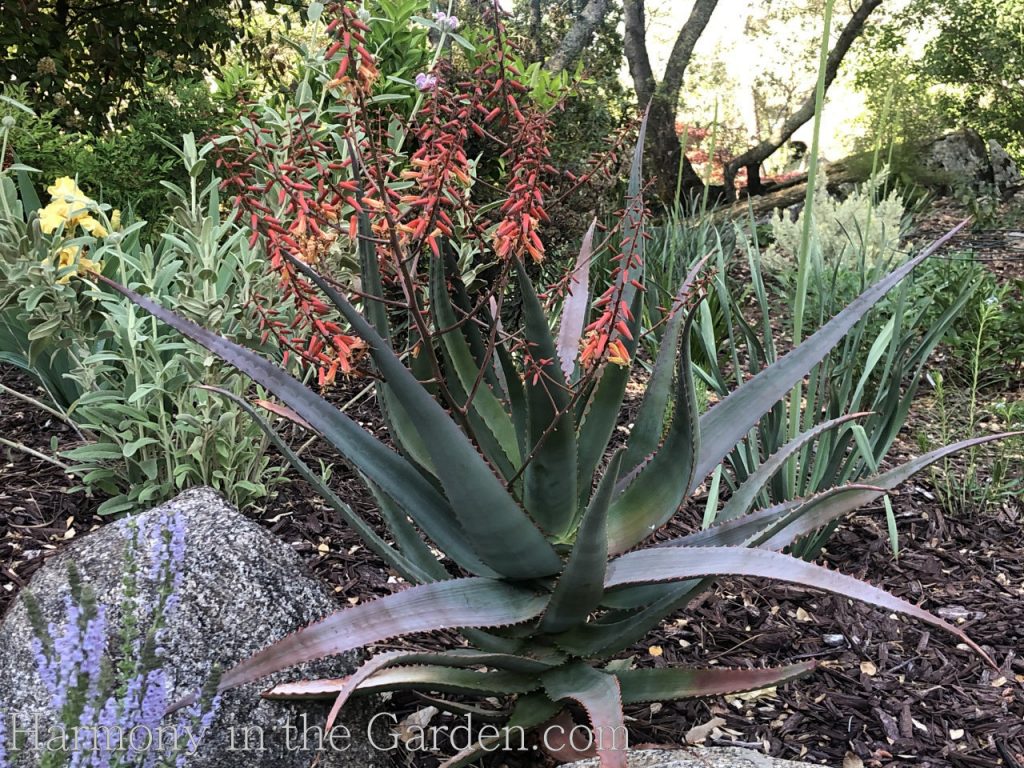
This is the first time it’s flowered with its branched candelabra of candy corn-like flowers, and it’s still going strong after four weeks!
I hope it sends out a baby soon so I can transplant it elsewhere in my garden, but so far, it remains a single 3’x3’ specimen.
6. Spirea japonica ‘Double Play Red’
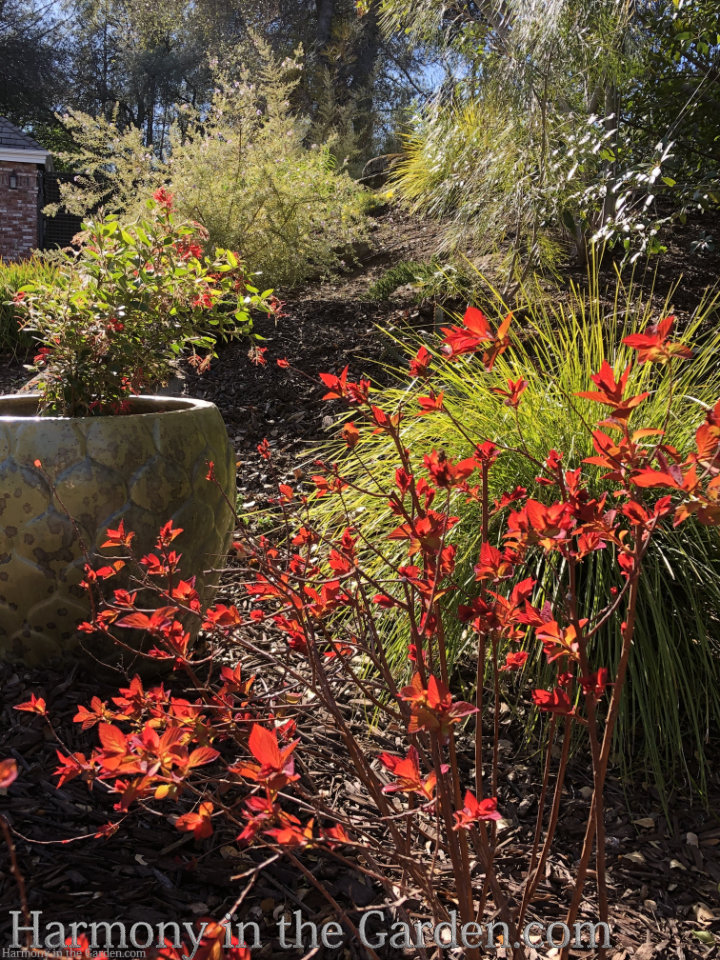
Proven Winners sent this to me three years ago to trial in my new garden. What started as a scraggly 4” plant has quickly blossomed into this eye-catching 3’x3’ shrub.
There are several other colors within their ‘Double Play’ line, but the ‘Red’ (which is really a dark, dark magenta) is my favorite.
The ‘double play’ in the name refers to unusual shades of burgundy in the first flush of new foliage (left.)
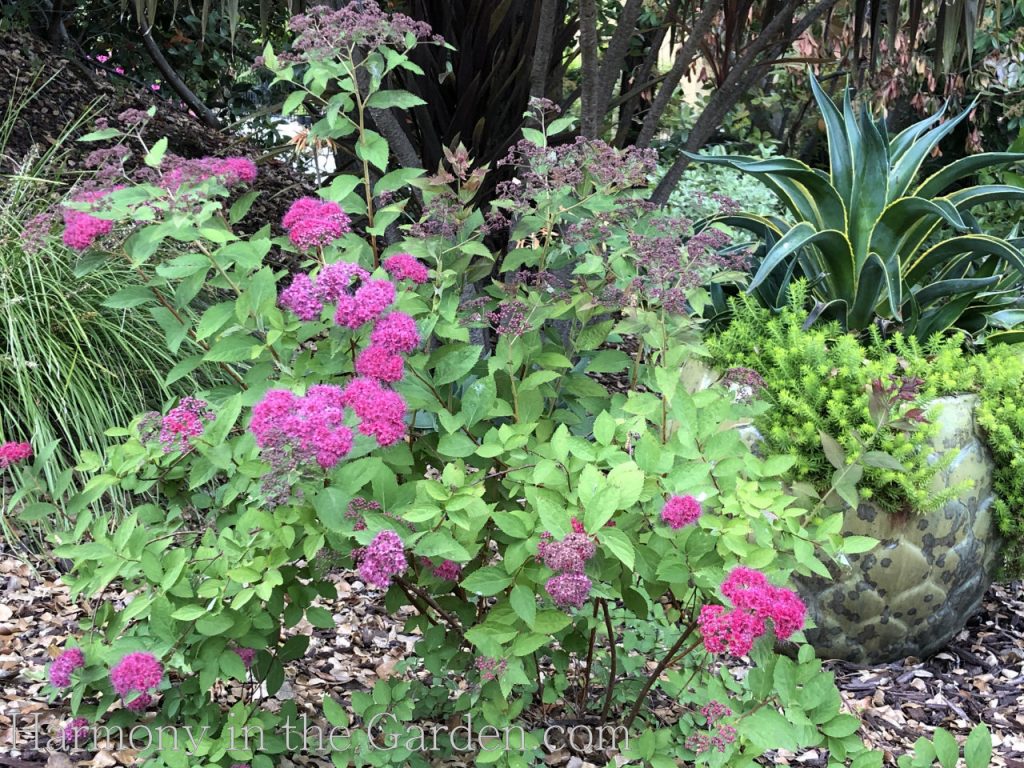
7. Salvia purpurea (Sage)
Growing at the base of my spirea (above) is this 3-year old salvia purpurea. I’ve planted this sage a lot over the years, and it never fails to delight my clients with its smoky gray and soft purple foliage.

It’s fairly low-growing (2’ x 3’) and remains lush throughout the year, losing only about half its leaves in the winter. It’s the perfect plant to place in the front of the border.
This time of year it’s especially attractive with its 2” tall light purple flowers, attracting every hummingbird in the neighborhood.
A lot of people ask me if its edible, and I’m happy to say that it is!!
It’s definitely my favorite drought-tolerant herb.
8. Amsonia hubrichtii (Blue Star and ‘Blue Ice’)
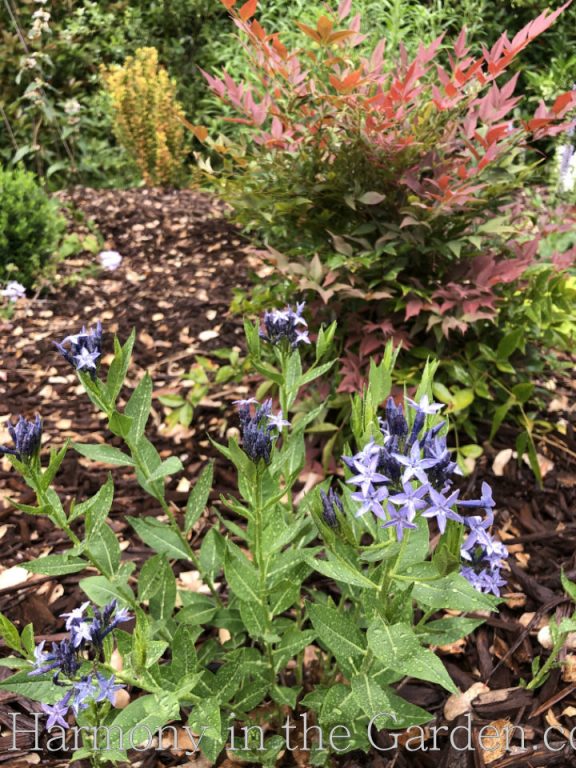
I’ve planted two cultivars of our native amsonia throughout my new rain garden, and love them both.
The more familiar a. hubrichtii (Blue Star, featured below) has pale blue flowers and wispy foliage while the compact ‘Blue Ice’ (on the left) has thicker leaves and much darker flowers.
Both varieties turn brilliant gold in the fall, adding another season of interest before winter arrives.
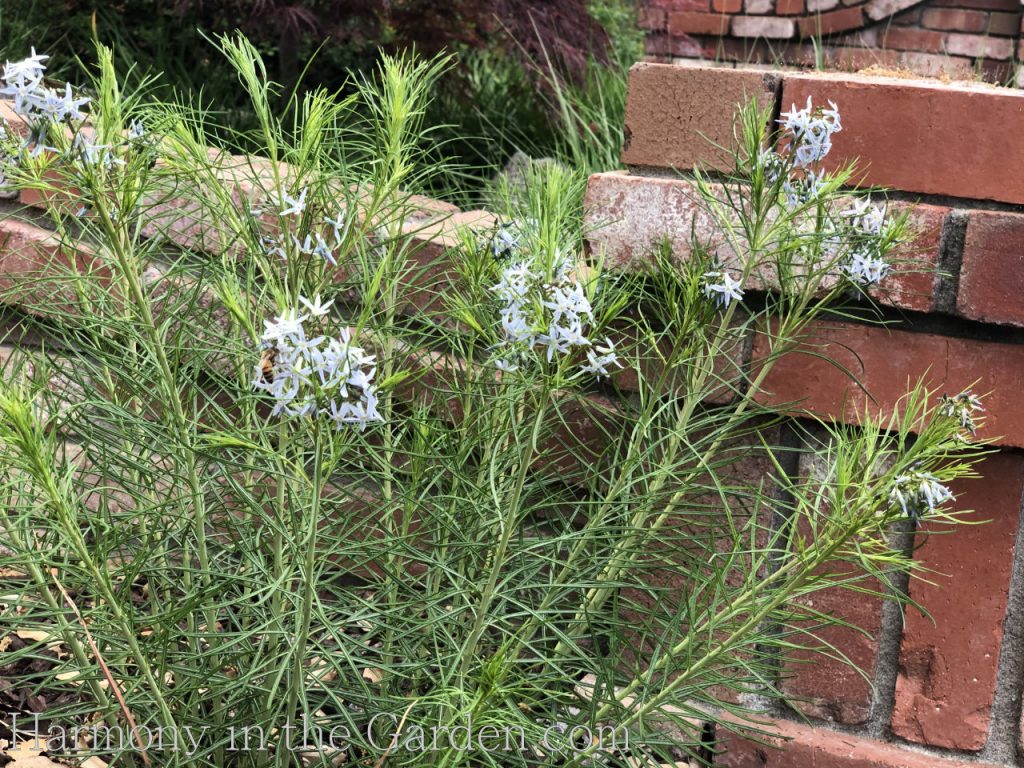
9. Heuchera maxima ‘Wendy’
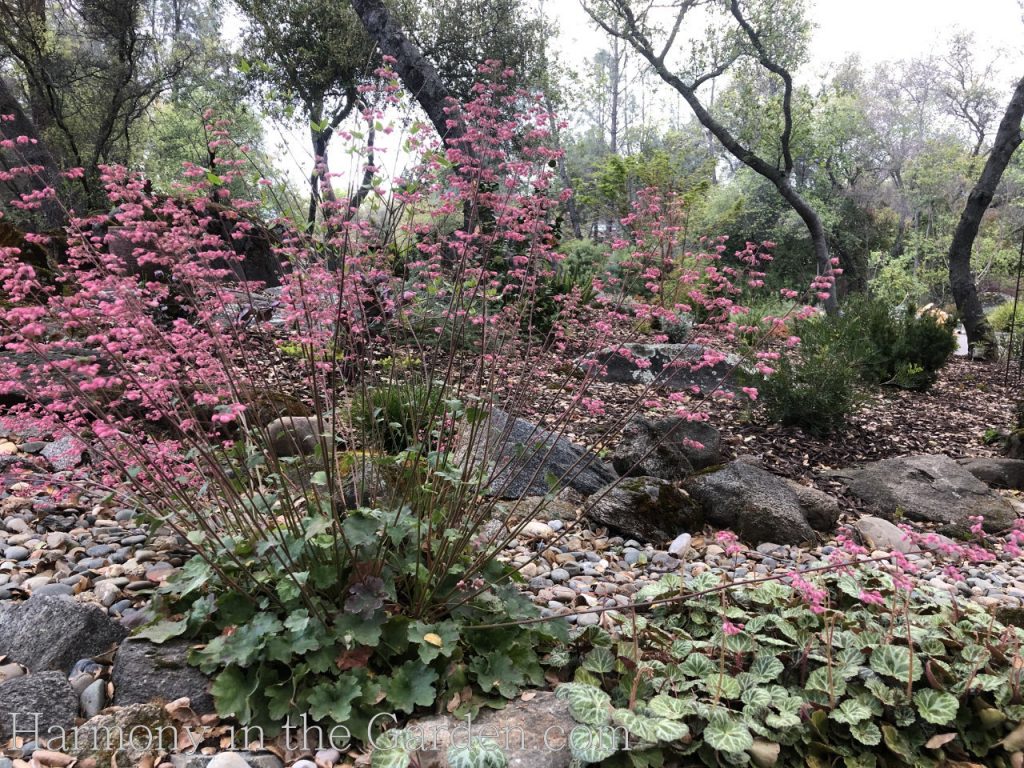
In the shadier section of my garden, growing under a canopy of Live Oaks, is a native heuchera ‘Wendy’, gifted to me when I first moved to Granite Bay.
It’s a biggie, growing to 2 ½-3’ tall, and in the early spring is covered will a million long wands of dark pink flowers.
Preferring dry shade, ‘Wendy’ is a natural to plant under oak trees.
As is the saxifraga stolonifera (Strawberry Begonia) that I planted right next to it.
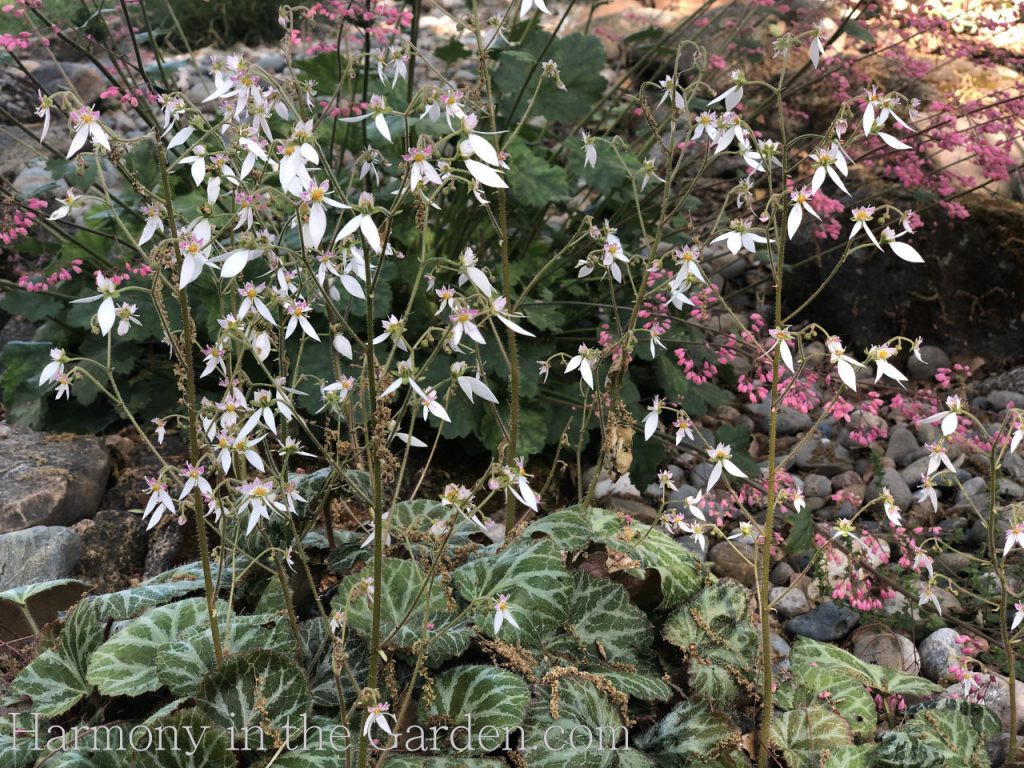
I found the Strawberry Begonia at a plant sale, for a mere .50 cents. The woman who sold it to me warned it would ‘wander.’
And wander it does!
But I don’t mind, as it’s easy enough to pull out should I need to. Plus, the airy wands of white and pink flowers are so beautiful intermingling together, don’t you think?
(Besides, including this plant was a sneaky way for me to include one more to add to my Top 10 list!)
10. Clematis florida ‘Sieboldii’
Last, but not least, is this gorgeous clematis which was given to me by my mother ((the very first pic in this article was taken from her garden.) She had it growing in a small pot under her carport for years and once I planted it in the ground, it exploded with growth.
It’s the very first clematis to bloom in my garden, and would bloom off and on throughout the year in my mother’s garden (even producing a few flowers in December!)
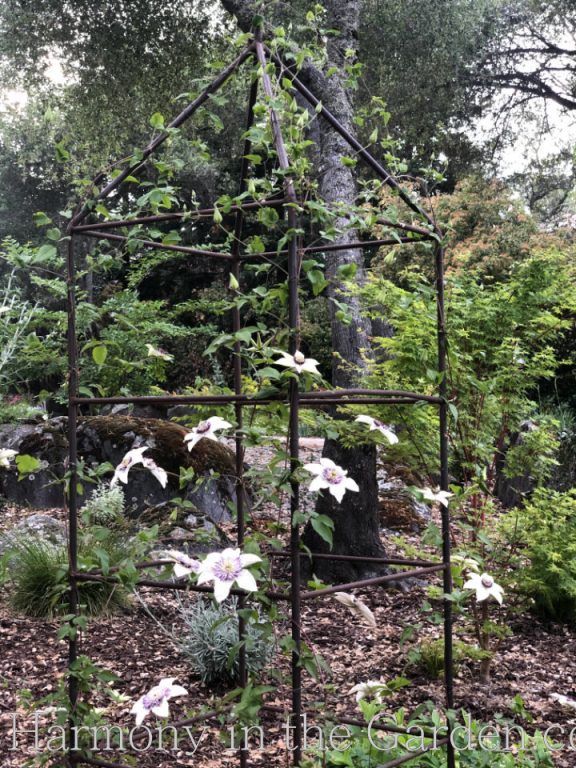
‘Seiboldii’ is thrilled growing under the dappled shade of my oak trees, getting to stretch itself out in its new home.
It’s a show-stopper, for sure, having seen several people drive by and stop their car, pointing to the oversized 9’ trellis covered with blooms.
This clematis can be challenging to find (only having seen it offered at a nursery once!), but I’ve seen it offered before in various online nurseries, including Monrovia.
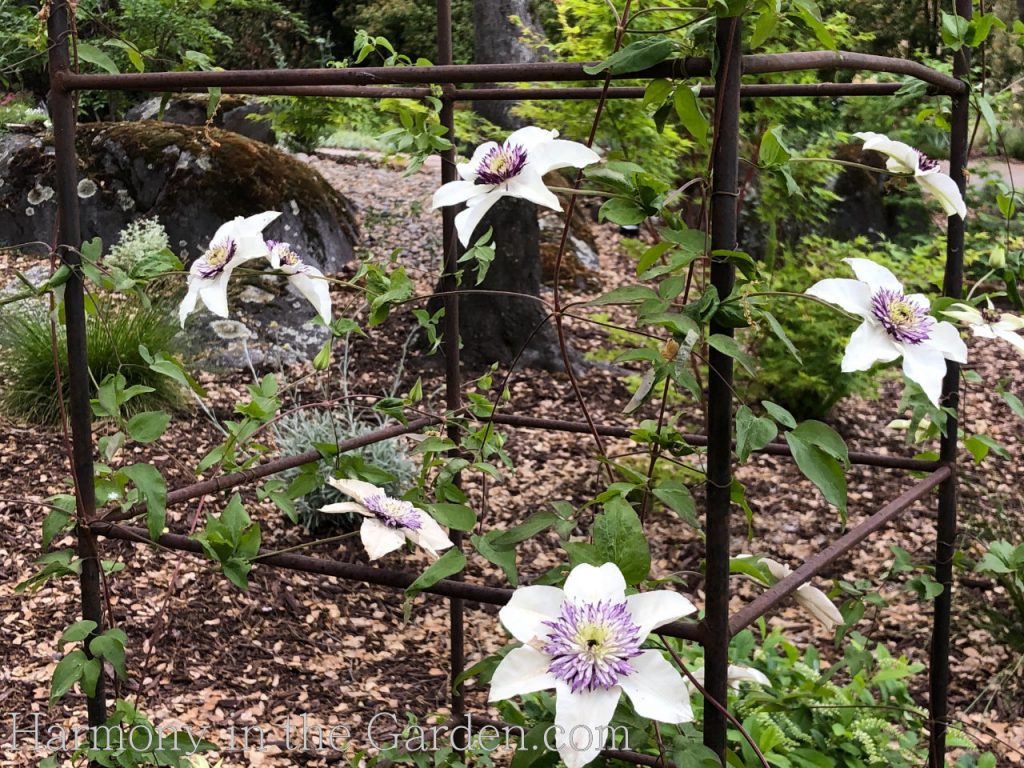
I hope you’ve enjoyed this tour of my spring garden!
So what’s growing in your garden right now? I’m always on the lookout for interesting deer resistant, low water plants! Any treasures you’d like to share with us?






8 Comments
Yours is the truly beautiful web site! Seldom have I found deer resistant plants, so thank you for the list. I had a wonderful garden in Palo Alto and an English garden in Half Moon Bay, but have had to trim my garden ambitions in the Sank.ta Cruz Mountains at 1200 ft elevation. Everything has been a lively experiment! Tulips perform well, but we have ground squirrels and gophers, who must be starving, to witness their omnivorous palates! I’m testing saffron crocus, just to see if we can survive up here, need be. Zucchini and cucumbers are fine. Is there a remedy for rodents in general?
Hello Ann, and thank you so much for such kind words about my website! Made me smile this morning. 🙂 As you’re painfully aware, deer are so regional that what might be resistant in one area, can be a gourmet treat to them in another. I’ve had great look with deer resistant plants in Los Altos Hills that seem to be tastier to deer in Portola Valley. It’s an expensive lesson in trial and error, I suppose. Squirrels are right up there with the deer, in terms of peskiness (or not, depending where you live!) and when I lived in Los Altos they were an absolute nightmare! But here in Granite Bay, they leave my plants alone, preferring to eat all the acorns (and bury them throughout my garden). Euphorbia and grevillea are two species I’ve yet to see anything at all eat – and lucky for us there’s so many varieties of them available. Have you seen my other blog posts about them? If not, just enter euphorbia and grevillea in my search box on the side bar. I love Capital Wholesale in East San Jose and have used them for decades. They sell to the public, too, and can bring in a wide variety of grevilleas if you give them a heads-up (more than nurseries seem to have.) I wish you the best of luck!!!
Rebecca, Where did you get the square bottom tuture? (sp) Thanks, Carl
Hello Carl, unfortunately that was custom made years ago by a man in Auburn who is no longer building them (I think he moved) I’m not sure where you live, but I’ve seen some really nice trellis and climbing supports at Cottage Nursery in Petaluma (http://cottagegardensofpet.com/cgartisantrellis.htm) If you find something similar please let me know as I get asked that question all the time! Thanks 🙂
Thank you for your top 10 list Rebecca. I’m going to be adding to my front garden and am looking for deer resistant, yet pretty and interesting plants. I love the orange iris and the grevillea you included. It is always a pleasure reading your blogs!
You’re so welcome, Vivian! And thank YOU for my favorite heuchera! I now have about 6 babies that I started from it, and my mom is next in line to receive two of them. I wish we could’ve scheduled a garden visit this spring. Darn! Hopefully we can do it once it starts to cool off again (fingers crossed) Take care and we’ll talk soon! 🙂
Such a wonderful tour of your Spring plantings!
I have several varieties of Salvia, some that I know, and some that have lost their tags and thus are now mysterious! However, they all do well on moderate to low amounts of water and the hummers absolutely love them, as do native bumblebees. I really enjoy watching them steal the nectar from the slits that they create near the base of the throat. One amazing thing that I saw earlier this year was a little band of bushtits feeding on the nectar using the slits made by the bumblebees! I had no idea that they would do that!
Hi Ronnie – I had no idea the bumblebees make little slits in the flowers – I’m definitely going to have to pay closer attention!! And I agree some of the salvias are pretty amazing this time of year. I actually have an upcoming post all about them (last count, I have something like 15 varieties that bloom throughout the year) and I was waiting for some of the summer bloomers to do their thing so I can take some more photos. Happy gardening!